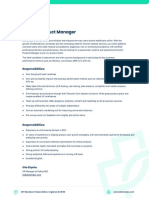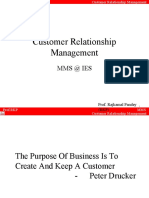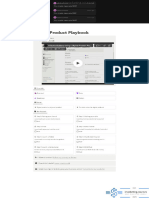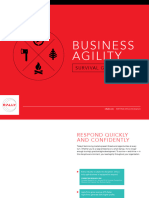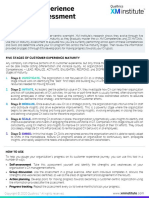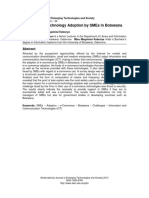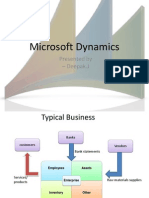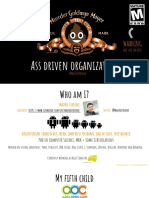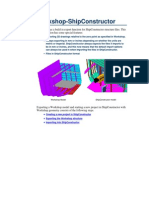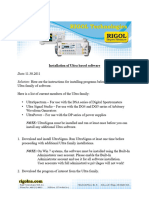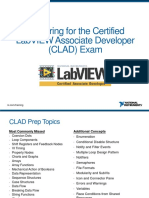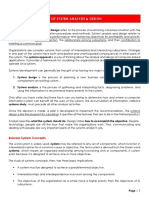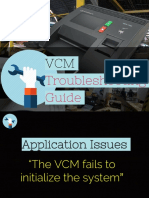Inspired PDF
Marty Cagan
Scan to Download
� Inspired
How to create tech products customers love
Written by Bookey
Check more about Inspired Summary
Listen Inspired Audiobook
Scan to Download
�About the book
In an era when numerous products exist, what kind of product
can stand out? The author of Inspired has summarized his
twenty years of practical experience in tech product
management. He explains how to create products that
customers love in great detail from three dimensions: how to
assemble an excellent product team, how to use an optimized
process to create products that customers love, and how to
determine the features of the products customers love.
Scan to Download
�About the author
The author of this book is Marty Cagan. When working for
Hewlett Packard in the early days of his career, he once had
the embarrassing experience in which the products he
developed could not be sold. In the twenty years since then, he
has accumulated abundant experience in product process
design during his work at first-class companies such as
Hewlett-PackardÿHPÿ, Netscape Communications, and
America Online. He is known as a highly experienced product
manager. He also served as the senior vice president of
product management and design at eBay. He later founded the
Silicon Valley Product Group dedicated to helping software
companies develop product strategies and improve their
product development process.
Scan to Download
��Summary Content List
Chapter 1 : Overview
Chapter 2 : What kind of team creates excellent software
products?
Chapter 3 : What is the process for creating products that
customers love?
Chapter 4 : What product features do customers love?
Chapter 5 : Summary & Review
Scan to Download
�Chapter 1 : Overview
Hi, welcome to Bookey. Today we will unlock the book
Inspired: How to create tech products customers love.
There was once a young programmer who sacrificed
countless nights and weekends to develop a high-quality
software product with his team. This product not only won
many patents but was also translated into multiple languages.
The feedback was very positive after subsequent media
exposure. However, although they expected huge sales of the
product after its release, it turned out that nobody was willing
to buy their product.
What went wrong? The young programmer reflected on the
whole process from product development to product release.
He discovered that customers did not need this product at all.
No matter how excellent the product was, it was pointless if
customers didn’t buy it. Since then, he decided not to devote
any more time and energy in a product unless customers
desired it.
The author of this book, Marty Cagan, is the programmer in
this story. He was a software developer at HP in his early
Scan to Download
�years. Over the next 20 years, he developed many successful
high-tech products for first-class companies such as Netscape
Communications and America Online. He also served as
senior vice president of product management and design at
eBay. He later founded the Silicon Valley Product Group,
dedicated to helping software companies develop product
strategies and improve their product development process.
This book is a summary of Cagan’s years of career
experience in product management. It will teach you how to
create tech products that customers love from the aspects of
team assembling, process optimization, and product
development. This book is regarded as a must-read classic by
product managers, and serves as their guide to action. Cagan
believed that software product development teams, especially
product managers, should read this book. In addition, this
book is also applicable to user experience designers, software
architects, software programmers, project managers,
marketing managers, and other managers. In an era when
everyone can produce products, more and more people need
to have product thinking, and the methodology they often
lack is exactly what this book offers. This book is not only
intended to teach general managers; it is also intended to
inspire working professionals.
Scan to Download
�In this bookey, we will unlock this book in three parts:
Part one: What kind of team creates excellent software
products?
Part two: What is the process for creating products that
customers love?
Part three: What product features do customers love?
Scan to Download
�Chapter 2 : What kind of team creates
excellent software products?
A product is designed and developed by the members of a
product team. Whether a product is good or not depends on
the team. Therefore, what kind of team is assembled and how
team members' responsibilities are defined ultimately
determines a product’s success.
Let’s start with recruiting. Cagan believed that a product
team should include the product manager, user experience
designer, project manager, development team, operation and
maintenance team, and product marketer. These roles are
indispensable for creating a successful product, and they are
also the choice of most successful companies. Once a team is
assembled, responsibilities should be defined, tasks should
be assigned, and collaboration should be commonplace. The
core of a product team are the product managers. They have
two main responsibilities: evaluating product opportunities
and defining products.
What does it mean to evaluate product opportunities? There
are many sources of product ideas, such as company
Scan to Download
�executives' opinions, user feedback, and marketing team
ideas. However, it is easier to think of an idea than to turn it
into a successful product, so you have to be very cautious.
Product managers are needed to evaluate these ideas and
decide whether they are golden or rotten. This is what is
means to evaluate opportunities. Once the product
opportunities are confirmed, the product manager will
perform their other responsibility: defining products. How
products should be defined will be explained in detail later.
Now, let’s talk about user experience designers. They are not
individuals; instead, they comprise a small team. The key
role in the team is the interaction designer, also known as a
user interface designer. Their task is to understand the
psychology of target users and work with product managers
to design user navigation systems and product manuals that
are user-friendly, comfortable, and easy to operate. For
example, the Amazon website has a clean and tidy interface.
Apart from the regular classification links, it also has very
clearly categorized keyword links. Users can easily choose
and buy products on the website, and they appreciate the
user-friendly webpage design. The interaction designer and
the visual designer can take credit for this.
Scan to Download
�When the product design is complete, the developers, also
known as software engineers, should start product
development. Once the developing team undertakes the
project, the project managers come into play. Their main task
is to make project plans and follow up on the progress,
ensuring that the product can enter the market smoothly.
Since this book is mainly about developing software and
Internet products, it focuses particularly on the importance of
ensuring the regular operation of Internet services. Once a
server goes down, it must be repaired by professionals, so the
operation and maintenance teams are also indispensable. If
everything goes smoothly and the product is made, there
must be someone to sell it. The product marketers are
responsible for organizing the release of information to the
public. They write advertisements to publicize the product,
expand marketing channels, and organize major marketing
campaigns. In short, they use every available means to sell
the product.
That covers the main components of an entire product team.
Of course, a proper composition ratio is critical. For
example, every five to ten developers should be equipped
with one product manager. One interaction designer can
support two product managers’ work, while one visual
Scan to Download
�designer can support four interaction designers.
Is it enough to develop an excellent product with an excellent
team? Of course not. Successful products are rare, while
failed cases are countless. It is thought that up to 90% of
products in a market fail for various reasons. However,
Cagan believes that the fundamental reason is the failure to
clearly define the responsibilities of product managers. Thus,
how can companies enable product managers to better
promote product management?
First, assign a principal product manager for every product.
The product manager decides what product to develop, and
the product marketer is responsible for publicizing the
product. Their responsibilities should be clearly defined.
However, in reality, companies often make three mistakes.
First, they allow marketers to define products. Second, the
marketers and the product managers share the responsibility
for defining products. The marketers are responsible for
high-level business needs. At the same time, the product
managers take care of low-level product needs, leading to
dispersed responsibility. No one is held accountable for the
product. Third, the marketing manager also serves as the
product manager, who tried to manage both, but both failed.
Scan to Download
�Cagan believed that a company should let professionals do
what they are a professional in. No matter how simple it is, a
product deserves the full devotion of a full-time product
manager.
Second, distinguish between product management and
project management. The key difference between the product
manager and the project manager is that the former focuses
on planning while the latter focuses on executing. In the
traditional retail software industry, product managers often
also serve as project managers. For example, Microsoft
Office products are developed using this approach. However,
while this approach can be used for retail software products
and the Internet in the early stage, it’s not suitable for
developing Internet services. Why is that? In the retail
software industry, products are usually released in the form
of independent installation packages. The release interval can
be several months or several years. The product and the
project are synchronized. Therefore, a product manager can
also be a project manager, combining planning and
execution. However, the release cycle is significantly
shortened with current Internet services. Sometimes, there is
a need to release once a week. Thus, the development cycle
is longer than the release cycle for most projects. As the
Scan to Download
�development and release of a product cannot be
synchronized, product managers can't cover both, making it
necessary to establish an independent project management
team. Upstarts, such as eBay and Google, boast strong
project management teams that coordinate project
management, program development, and website operation
and maintenance.
Third, focus on holistic user experience design. Good
products rely on design, and they should provide a good user
experience. However, many companies lack product design
awareness and fail to understand the importance of it. User
experience design includes four roles: user research,
interaction design, visual design, and prototyping. The goal
of user research is to study the preferences of target users.
Interaction designers design functions, user navigation, and
product manuals according to users’ needs. Visual designers
design the user interface. Prototype makers create a product
prototype and make iterations according to users’ feedback.
Throughout the whole process, product managers are
indispensable. They need to understand and collaborate
closely with these four roles in order to produce products that
meet users’ expectations. For example, Apple is very
concerned about all of the tiny details of user experience
Scan to Download
�design. If you are an iPhone user, you may notice this in the
Clock app icon. The second hand moves continuously in the
default setting, but it ticks every second when you edit the
home screen.
Fourth, the product manager works closely with the
development team. Successful products need to satisfy users’
real needs and also be feasible. This balance relies on the
cooperation and interdependence between the product
manager and the development team. Only through close
collaboration, when the product manager defines the right
product, and the development team develops the product in
the right way, can a satisfying product be created.
Do you think that product management is rigorous and being
a product manager is a very demanding job? Well, it’s true.
Product managers are the most critical role in the product
team. They must have the ability to spot a problem, analyze
it, and then solve it. This ability should be reflected in
product definition and product design, as well as
coordination up and down within a company. So, what
qualities does an excellent product manager have? And how
can you find an excellent product manager?
Scan to Download
�Product managers need many qualities, but there are three
that are most important. First, they should have a passion for
the product. Steve Jobs once said, ‘People with passion can
change the world.’ Being passionate is an essential quality
for a product manager. Second, they should have empathy for
users. Product managers must understand their target market
and consider products from the users’ perspective. This
means that they should put themselves in the users’ shoes
and be fully devoted to exploring target users’ experiences,
preferences, values, perceptions, tolerances, and technical
understanding. Third, they should have product thinking,
which means professionalism. Product management requires
intense business instinct, keen insight, and intuitive
judgment.
When most companies recruit product managers, they prefer
people with strong work experience or MBA graduates from
top business schools. However, Cagan believed that excellent
product managers, regardless of age, qualification, or
occupation, can come from departments within the company
or from the group of target users, as long as they have the
above qualities.
That’s all for the first part: what kind of team creates
Scan to Download
�excellent products. First, you need to assemble an excellent
product team, and the selection of each team member matters
a lot. Among these roles, the product manager is the most
crucial one. Companies should empower product managers
to have independent responsibilities and allow them to carry
out high quality product management. Of course, an
excellent product manager should have a passion for their
products, empathy for users, and product thinking.
Scan to Download
�Chapter 3 : What is the process for
creating products that customers love?
Next, let’s look at the second part: the process of creating
products that customers love.
Successful products must have matured and tested routines,
which are also known as the process. The process, as
introduced in this book, is very informative. Here, we
summarize it simply into four phases: first, the evaluation of
product opportunities and product discovery; second, user
research; third, product validation; and, fourth, product
development.
First, let’s talk about the evaluation of product opportunities
and product discovery. We mentioned the evaluation of
product opportunities in the first part when we were
discussing product managers’ responsibilities. In order to
avoid developing unpopular products, product managers
screen collected ideas, get rid of unreliable or bad ideas, and
select the product opportunity that is suitable for the
company to develop. After finding the ideal product
opportunity, the product manager should systematically
Scan to Download
�evaluate the following issues:
What problem is the product solving?
What is the target market?
What is the probability of developing a successful product?
What are the competitive products?
What is the company’s competitive advantage?
After completing these evaluations, they then decide what
product to develop.
After a product plan is determined, product managers should
conduct product discovery, which is also known as defining a
product. What is defining a product? In short, product
managers search for the target market according to collected
user needs and then develop product solutions. After the
value, usability, and feasibility of a product is ensured, a
high-fidelity user prototype is created. It gets tested by real
target users and development teams in order to validate that
the product is worth developing.
Here, we mentioned high-fidelity user prototypes. A
low-fidelity prototype is a drawing on paper, while a
Install Bookey
high-fidelity App istothe
user prototype Unlock Full Text and
closest resemblance to the
Audio
final product that is possible to make. It satisfies the basic
requirements of value, usability, and feasibility. It is a
Scan to Download
��Chapter 4 : What product features do
customers love?
We’ve now discussed the product team and the process.
Next, we want to share the three features of the products
customers love, which are also every product’s soul.
First, good products must satisfy the needs of mass users. A
product can be recognized when it meets most users’ needs.
Imagine, if a user can’t do without the core function of a
product, they can hardly dislike the product. Even the
so-called innovative products need to obey this rule of
meeting the needs of the mass users. In addition, many
successful products are not entirely new things; instead, they
are old things that have been improved upon with new
technologies. For example, hundreds of mobile phones
existed before iPhone entered the market, but their voice mail
systems were incompatible with their address books, and
they had lousy web browsers that hadn’t changed for more
than a decade. Apple improved these functions and instantly
met users’ unsatisfied needs, thus immediately winning the
hearts of these users. Many users have been crazy for Apple
products ever since.
Scan to Download
�Another typical example is Google. When they first stepped
into the search engine industry, they were mocked by many
people who believed it impossible to gain a share of the
search market as a new comer. However, the reality proved
people wrong. After a lot of research, Google determined that
valuable information was a permanent user need. Therefore,
they focused on this need and won users’ hearts,
overthrowing all previously established market patterns. In
2019, Google’s market share accounted for 80%, making it
the predominant leader in the search engine market.
Second, good products must serve users’ emotional needs.
What can persuade users to use your products continuously
the way that Apple fans remained obsessed with the iPhone
for more than a decade? Some people believe it is due to the
iPhone’s powerful product functions, which is not wrong, but
only a part of the reason. In the fiercely competitive current
market, functions alone are not enough to satisfy users. More
and more users care about satisfying their emotional needs.
For example, some Internet companies send you birthday
greetings on your birthday, while other products can help
relieve negative emotions; users log into Facebook to satisfy
their social needs as well as alleviate loneliness.
Scan to Download
�Different users have different emotional needs. For example,
some eBay consumers spend freely, some constantly look for
discounted products, and some seek excitement from
bidding. Developers need to fully realize the emotional needs
of test users and respond to those needs. By doing so, they
can develop products that arouse users’ emotional feelings,
ensuring that an order will be placed sooner or later.
Another bookey of Crossing the Chasm introduces a concept,
technology adoption curve, to describe users. Yahoo’s former
vice president, Jeff Bonforte, proposed to use the ‘emotional
adoption curve’ to describe users apart from the technology
adoption curve. Cagan also emphasizes this idea in this book.
Based on consumers’ emotional characteristics, consumers
should be categorized into the following five groups: Lovers,
Irrationals, Efficients, Laughers, and Comfortable. Jeff
believed that we should pay most attention to the Irrationals,
who are the main force of consumption and whose emotional
needs are the strongest. Therefore, we must grasp these
users’ emotions so that we can better understand what kind
of products we should design.
Third, good products feature both usability and aesthetics.
Scan to Download
�Usability is defined as how easy it is for new customers to
learn and use a product. In addition, aesthetics are also
essential. For example, when surfing the Internet, we are
often attracted to a website due to its well-coordinated color,
pretty font, beautiful layout, and clean interface. But all of
these advantages are pointless if the interface’s navigation is
so chaotic and confusing that we feel lost and can’t get to the
target we are looking for. We often stop using websites that
have good aesthetics but bad usability after the first attempt.
On the other hand, some websites have a very logical
navigation design, and we find it easy to access the
information we need. However, we are not attracted to
websites if the interface design is dull and lacks aesthetics;
thus, we probably won’t spend much time using it.
That’s all for the third part: the product features that
customers love. To sum up, there are three product features
that customers love:
Good products must meet mass users’ needs.
Good products must serve users’ emotional needs.
Good products must feature both usability and aesthetics.
Scan to Download
�Chapter 5 : Summary & Review
Finally, let’s review what we have talked about today
regarding how to create products that customers love.
Part one: what kind of team creates excellent products? First,
it is necessary to assemble an excellent product team, and the
selection of each team member matters a lot. Among these
roles, the product manager is the most crucial one.
Companies should empower product managers to have
independent responsibilities and allow them to carry out
valid product management. Of course, an excellent product
manager should have a passion for products, empathy for
users, and product thinking.
Part two: improving the process of product development.
First, product opportunities must be evaluated and product
discovery must be conducted in order to find out if the
product is worth developing. Second, user research must be
conducted to ensure that the product is valuable, usable, and
feasible. Third, the product’s value, usability and feasibility
must be validated. Finally, products should be developed
using the Agile method.
Scan to Download
�Part three: the three product features that customers love.
First, good products must meet mass users’ needs. Second,
good products must serve users’ emotional needs. Third,
good products must feature usability and aesthetics.
Making a product that no one needs is a big waste of time
and money. But an excellent product team and an
outstanding product process can produce high-quality
products full of warmth and love. They will make their way
in the world no matter how fierce the market competition is.
Scan to Download
